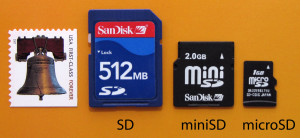microSD

(TransFlash)
A type of removable flash memory card designed specifically for mobile phones.
Like any flash memory card, it can be used for long-term storage of various types of files, including photos, videos, music, or software.
microSD is one of the smallest memory card formats available; a microSD card is about the size of a fingernail. It was designed to be smaller than competing formats, to allow phones using the format to be smaller overall. It is the most common type of removable memory card used in phones.
There are adapter cards that allow a microSD card to be used in a full-size SD card slot. This is a convenient way to use a microSD card with a card reader on a PC, to transfer files between a PC and a phone.
See: SD
Two extensions of the microSD standard support larger storage capacities. Cards with a memory capacity of 4 – 32 GB are microSDHC. ("HC" stands for "high capacity".) The microSDXC standard supports even larger capacities of 64 GB – 2 TB. Cards with these capacities can only be used in devices that are specifically compatible with these standards. Some older phones do not support these specific standards, and therefore do not support cards with these larger capacities.
See: microSDHC
See: microSDXC
Some phones have an advertised maximum card capacity that is lower than what the relevant standard theoretically supports. This is often because the manufacturer was only able to test the phone with a certain size of card that was actually available on the market at the time the phone was developed. The phone may still work with larger cards in the future, but the manufacturer is not willing to guarantee what they have not actually tested.
A newer standard called UFS has also been introduced, which is similar but faster:
See: UFS
The microSD card format was first brought to market in 2004 as "TransFlash". In 2005, the format morphed into "microSD". It was mostly just a name change, as all microSD cards should be compatible with TransFlash slots and vice-versa. The format has also gone by the names "T-Flash" and "TriFlash-R".
See: miniSD



